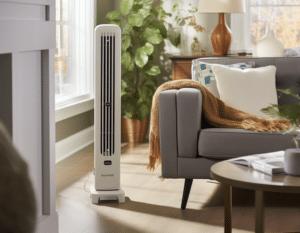Introduction – Outdated Electric Baseboard Heaters
Baseboard heaters circulate hot water or electric current through metal coils or fins that radiate heat. The heat then spreads through the room as the air around the baseboard heater warms.

With energy costs being very high, this is a great time to think about an overhaul of your heating system. Replacing electric baseboard heaters might be necessary if they do not provide enough heat to warm your home, are outdated and inefficient, or simply want to upgrade to a more modern heating system.
If your home is not being warmed sufficiently by your baseboard heaters, it is likely for one of two reasons. Either the heaters are too small for the size of your home, or something is blocking the flow of air around the heater, preventing the heat from circulating properly. In either case, replacing your baseboard heater with a newer system should solve the problem.
How To Replace An Electric Baseboard Heater?
You need to know a few things before shopping for a new electric baseboard heater.
First, you need to determine the size of the unit you need. Heaters are measured in BTUs or British Thermal Units. Rule of thumb: find the BTUs you need by following the table. Find what kind of climate your house is located in, example states are given.
Multiply the house square footage by the right BTUs per square foot. So if you have a 2000 square foot house in a cold climate, you will need a 100,000 BTU capacity heater.
| Climate Type | BTUs Per Square Foot |
|---|---|
| Cold (Minnesota, North Dakota, Maine, Alaska) | 50 |
| Moderate (New York, Virginia, Oregon) | 35-40 |
| Warm (Florida, Texas, Southern California) | 20-30 |
Second, now that you know how many BTUs you need, you can begin shopping for your new heater. Be sure to buy a unit that is appropriately sized for the room in which it will be installed.
If you get one that is too small, no surprise that it’ll be working constantly because the heat is escaping faster than it can be retained. If you get one that is too large, it’ll heat the space at the risk of costing more than you need.
Third, once you have your new heater, it’s time to install it. Roughly, the work will follow as this: Begin by turning off the power to the circuit on which the old heater is located. Next, remove the old heater from its brackets and unscrew any wires that are attached to it.
Now it’s time to install the new heater. Begin by attaching it to its bracket using screws or nails. Be sure the heater is securely in place before moving on. Tighten all connections and then screw on the wire covers. Finally, turn on the power and test the unit to ensure it works properly.

5 Alternatives To Baseboard Heaters
We summarize the 5 alternatives here and go into more detail below. Note that they have different efficiencies with the ductless heat pump and natural gas being the lowest cost per unit of heat output. Every choice has been standardized in terms of kWh of heat output although for natural gas furnaces typically its measured in therms of output.
| Heating System | Fuel Type / Energy Source | COP (Coefficient of Performance) | Cost per kWh of Heat |
|---|---|---|---|
| Ductless Heat Pumps | Electricity | 2.0 – 4.0 | $0.03 – $0.06 |
| High-Efficiency Furnace | Natural Gas | 0.8 – 0.98 | $0.035 – $0.043 |
| Infrared Heaters | Electricity | 1.0 | $0.12 |
| Convection Heaters | Electricity | 1.0 | $0.12 |
| Electric Fireplaces | Electricity | 1.0 | $0.12 |
The last 3 choices are the same efficiency as the electric baseboard heater.
1. Ductless Heat Pumps
Our number one choice for you is the ductless heat pump. Since the mid 2010’s, heat pumps have improved so much in their technological foundations that they operate in sub-zero temperatures, moving residual heat from the below zero environment into your already warm home.
From 2022-2023, during the energy crisis precipitated by the Russian-Ukraine conflict, Europeans en masse installed heat pumps which increased the efficiency of heating and reduced energy costs.
Heat pumps run on electricity but instead of converting it to heat, they use it to move heat from one place to another. The source of heat? On the outside, even in cold temperature, air molecules have heat that can be moved.
Yes, the colder it is, the less efficient it’ll be. But given that heat pumps are one of the most efficient heating technologies, you should ask for an expert opinion about it!
Ductless heat pumps are an increasingly popular alternative to electric baseboard heaters, and for a good reason. Depending on the size of your home and the climate you live in, you could save up to 30% on your energy bill by switching to a ductless heat pump.
Ductless heat pumps are versatile and can be used in various settings. For example, ductless heat pumps can be used to supplement your existing heating system, or they can be used as your primary heating source.
Finally, we note that the heat pump is the most efficient, ranging from $0.03 to $0.06 per kWh of heat.
2. High-Efficiency Furnace
Our second choice is a high efficiency furnace that works off natural gas. A high-efficiency furnace is a great alternative to electric baseboard heaters. Furnaces are more efficient than baseboard heaters because they use a sealed combustion chamber to extract heat from the air.
This means that less energy is required to operate a furnace, making it a more cost-effective option in the long run. In addition, furnaces can be more effective at heating your home evenly.
Electric baseboard heaters often create hot and cold spots in your home, while a furnace will distribute heat more evenly throughout the space.
Is heating oil an option? We don’t recommend it because it’s much less efficient than natural gas, to the point where your heating costs might be twice as high. It’s also a big hassle as the giant oil tanker in your basement takes an extra appointment every year to refill. The only reason to opt for heating oil over natural gas is if your residence doesn’t have municipal gas pipe connections.
And in fact, if you have any other option over heating oil, we recommend that instead, for example the #1 choice above of heat pumps.
But in short, a natural gas high-efficiency furnace is a great option if you’re looking for an efficient and cost-effective way to heat your home.
For numbers, the natural gas furnace is more efficient than electric baseboard, with costs ranging from $0.035 to $0.043 per kWh of heat
3. Infrared Heaters
Electric infrared heaters are an ok alternative to traditional electric baseboard heaters. Electric infrared heaters heat objects by emitting infrared light directly to objects in the room instead of convection or conduction through the air.
These heateres have about the same energy efficiency so won’t be affecting your energy bills. Electric infrared heaters come in various sizes and styles to fit your needs. You can easily install most electric infrared heaters by following simple steps.
First, choose a location for your heater. Second, mount the heater to the wall or ceiling using the included hardware. Third, connect the power cord to an outlet and plug in the heater. Finally, turn on the heater and enjoy the warmth!
These are like conventional electric heaters, with low efficiency at $0.12 per kWh of heat.
4. Convection Heaters

One alternative to electric baseboard heaters is a convection heater. Convection heaters work by circulating air around a room using a fan.
This results in a more even heat distribution, which can save energy costs. In addition, convection heaters are typically much smaller than electric baseboard heaters, making them ideal for use in smaller spaces.
To use a convection heater, simply place it in the desired location and turn it on. The fan will start circulating air, and the room will begin to warm up. Keep the door and windows closed while the heater runs for the best results. These are not really that efficient.
These are also like conventional electric heaters, with low efficiency at $0.12 per kWh of heat.
5. Electric Fireplaces
Electric fireplaces offer a safe and convenient alternative to electric baseboard heaters, emitting no smoke or fumes. Suitable for any room, these units come in various styles and finishes, enhancing the room’s ambiance.
They are equipped with features like remote control for easy temperature adjustments and a timer for automatic shut-off.
While electric fireplaces provide added warmth and atmosphere, their heating efficiency is comparable to electric baseboard heaters. This means low efficiency.
Consider the specific heating needs and insulation of their space when choosing an electric fireplace. We suggest two brands below:
Dimplex offers a wide variety of electric fireplaces, in styles, finishes, and mounting options. They are known for their realistic flame effects powered by innovative LED technology. One of their series is the Opti-Myst Pro Series, which provides a patented 3-dimensional flame effect.
Amantii is renowned for its sleek and contemporary electric fireplaces, suitable for homes, offices, or restaurants. The Tru-View Series is popular for its 3-sided view and can be used both indoors and outdoors.
This final option is also like conventional electric heaters, with low efficiency at $0.12 per kWh of heat.
Final Word: Consider Improving Your Insulation
All of the recommendations about sizing and efficiency is for an average home which tends to have poor insulation. And one of ShrinkThatFootprint’s tenets is that insulation is the absolute core reason why we need some much heating. If our insulation were perfect, one would need zero heating. Therefore, before investing in a new electric baseboard heater, homeowners should consider enhancing their home’s insulation to create a more energy-efficient and cost-effective heating solution. Use the ShrinkThatFootprint multi-step plan to improve insulation.
Conclusions – Replacing Electric Baseboard Heaters
In conclusion, replacing electric baseboard heaters with a more efficient alternative can save money and improve your home’s comfort level. There are several different options to choose from, so be sure to research and find the best option for your needs. By switching to a more efficient heating system, you’ll enjoy lower energy bills and a warmer, more comfortable home all winter long.
